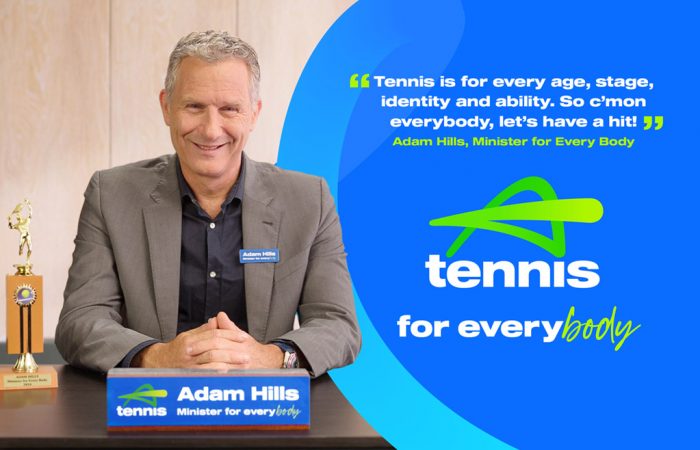Adam Hills reveals motivation for fronting “Tennis for Every Body” campaign
Australian comedian and television personality Adam Hills is a passionate tennis player and hopes to encourage more people to play the sport he loves.
Australia, 12 September 2024 | Leigh Rogers

Australian comedian and television personality Adam Hills is proudly fronting a new marketing campaign for Tennis Australia.
The “Tennis for Every Body” campaign, which launched last week, highlights the adaptive and inclusive pathways that ensures tennis is for everybody.
This is a cause that Hills, who was born without a right foot, is passionate about, as he explains in this interview with tennis.com.au.
Most people probably recognise me as the host of Spicks and Specks, but what they might not know, is that I’ve also been playing tennis since I was five years old. I have played competitively, I even coached for a while, but it was always against able-bodied people.
I have a prosthetic foot, which really doesn’t stop me from moving that much. I remember attending the Paralympic Games at Beijing in 2008 and I was talking to the coach of the Australian wheelchair tennis team. When he heard I can play, he invited me to jump in a wheelchair and train with them. I just thought ‘No, that doesn’t sound right’. But the way it is, my disability requires me to play wheelchair tennis. I remember thinking at the time, ‘I wish there was a better way I could play against people with similar disabilities, but while standing’.
Thankfully, I have. It turns out there is a growing movement around the world called Para Standing Tennis. The president is a Spanish guy Ivan Corretja, whose brother Alex is a former world No.2. He has a below-knee amputation and is leading the Para Standing Tennis movement, which is now recognised by the International Tennis Federation and played in more than 21 countries. I played in the first Para Standing Tennis tournament in Sydney last year. It was run by City Community Tennis, who regularly run adaptive sessions, and was supported by Tennis Australia. There were only five us in that tournament, so all the categories were lumped in together. But it was a promising start.
It’s standing tennis for people with disabilities, but there are different rules, depending on your disability. If you are a below-knee or an elbow amputee, it’s just the standard rules of tennis. If you’re short stature, an above-knee amputee or if you’ve got cerebral palsy that restricts your movement, then you get two bounces, which levels the playing field.
> LEARN MORE: Para Standing Tennis
Well according to Fitzy, my forehand is my best shot. It’s very solid and consistent. The weird thing is my backhand used to be really good, but I’ve lost it.
I’ve been really focused on building the profile of Para Standing Tennis and exploring the way we can make this more accessible for more Australians, which Tennis Australia is thankfully supporting. So, it’s been great to also learn more about the different adaptive formats available. It was fascinating to watch how people adapt to their disabilities to play tennis as well. From wheelchair tennis to pathways for those with Blind and Low Vision (BLV), an intellectual impairment (PWII) or Deaf and Hard of Hearing (DHoH), there really is something for everyone.
> LEARN MORE: Inclusion and Diversity pathways in Australian tennis
I’ve played tennis my whole life, so it’s not like I was ever excluded from the game, I just wasn’t able to play against other people like me. Having pathways for people of all abilities opens up a whole bunch of more possibilities. It also helps foster a great sense of belonging, which can be a big challenge for those of us with a disability.
Most definitely! Over the years I’ve spoken to several Paralympians, who have won gold medals in their respective sports, but have said they would have much rather played tennis. It just hasn’t always been an accessible option for everybody, but that really is changing now, which is so pleasing to see. This campaign is not only about those with a disability either. It is also about promoting the sport for players of every age, stage and identity and dispelling myths about who can and can’t play tennis. Whether you’re young or old, fit or unfit, straight or queer, or only have one foot. Everyone is welcome and capable of playing tennis.
Do it, what are you waiting for?! Tennis is a lot of fun and really is an inclusive sport. Get out on court and give it your best shot.
Find your way to play: Visit play.tennis.com.au to get out on court and have some fun!